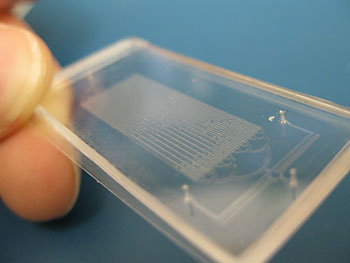For your New Year’s pleasure, bacteria coaxed into performing a light show. Okay, that’s not the main purpose behind the work of Jeff Hasty and his colleagues from the University of California, San Diego. The researchers are using similar methods to create living sensors of arsenic and other toxins.
The performance art required the development of two components. First, the bacteria had to be engineered. Microbes that glow on command do not exist in nature. To get them to do so, the biologists tied genes involved in fluorescence to each cell’s biological clock. By introducing the right chemical signals, Hasty and his team were able to synchronize the firing of those genes and get the bacteria to glow in unison.
The second component was the apparatus in which to place the bacteria. For this, the bioengineers built microfluidic chips, no larger than a microcscope cover slide. Each chip contains up to 13,000 individual chambers with about 5000 bacteria per chamber. Collectively, the bacteria in each chamber make up one point of light, dubbed a biopixel. By sending the right signals to each chamber, the millions of bacteria in the chip can be induced to perform a dance of light, or to spell out your alma mater.

A microfluidic chip
Credit: UCSD
It’s not all pretty pictures though. The bacteria can be further tweaked so that they flash more slowly in the presence of arsenic or other harmful substances. Hasty predicts that biosensors will one day be used to monitor samples for toxins.
You can see the bacteria in action below:
No comments:
Post a Comment